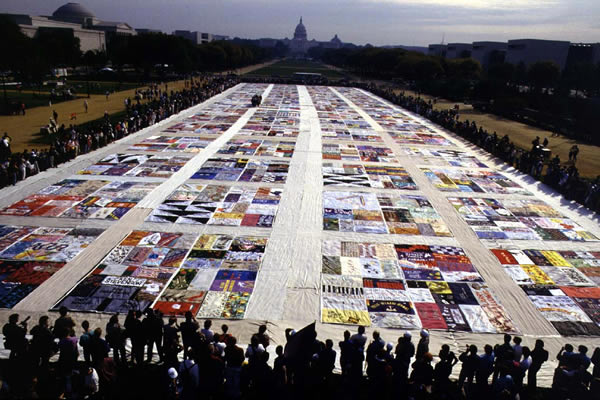Arts & Entertainment
Unfurling the Quilt
D.C. residents have multiple opportunities to see AIDS memorial in coming weeks
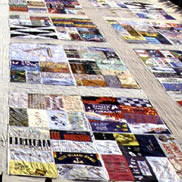
The 1 million annual visitors to the Smithsonian Folklife Festival have rarely expected to engage in an international discourse about AIDS at the event in the past. This year, however, attendees can tell their own stories regarding HIV/AIDS through a variety of creative outlets and add to the already massive AIDS Memorial Quilt that will blanket part of the National Mall.
For the first time in the festival’s history, the Smithsonian Center of Folklife and Cultural Heritage is collaborating with the NAMES Project Foundation with the program “Creativity and Crisis: Unfolding the AIDS Memorial Quilt.”
The NAMES Project Foundation, established in 1987, is the Atlanta-based international organization that houses and maintains the AIDS Memorial Quilt. About 8,000 of the quilt’s 48,000 panels will be featured at the Folklife Festival to commemorate the quilt’s 25th anniversary and educate visitors about how art has been utilized to address an international epidemic.
“It’s a lovely collaborative effort between the Smithsonian Center of Folklife and Cultural Heritage, who are the presenters along with us,” Julie Rhoad, executive director of the NAMES Project, says. “It’s been a delight working with the curatorial team at the Smithsonian.”
The festival starts Wednesday and will continue through July 1, and will be held again from July 4-8 on the National Mall between 7th and 14th streets. Admission to all events is free. Festival hours are from 11 a.m.-5:30 p.m. each day and special events such as concerts and dance parties begin at 6 p.m.
“Creativity and Crisis: Unfolding the AIDS Memorial Quilt” will include a multitude of craft demonstrations, dance and musical performances, theater, children’s activity areas and interactive discussions that will complement the presence of the quilt at the festival. Many of the featured performances will be by artists who have been affected by HIV and AIDS. Visitors will have the opportunity to help make panels that will be incorporated into the quilt, and to tell their own stories.
“We receive a new panel on the average every day, every year. Right now we have I think several hundred that are already in our possession that during the Folklife Festival we will have Gert, who’s been with us 25 years, bundle and sew them on the National Mall,” Rhoad says. “There’s a whole host of creativity and expression around HIV and AIDS and the domestic and global efforts in expression, all centered and viewed through the lens of what the quilt has done.”
In the event of a rain, the NAMES Project has an expertly organized plan called the “rain fold” to protect the quilt.
“Each time we’ve been in D.C. we’ve had to deploy the plan. Amazingly, what happens is we have plastic and we have a way it gets folded up, then we take it under tents,” Rhoad says. “It’s an amazing thing to see. It’s what happens when you’re in the presence of the quilt.”
In addition to their display at the Folklife Festival, many of the quilt’s 48,000 panels will be on the National Mall again from July 21-25 during the start of the International AIDS Conference. About 40 locations throughout the Washington metropolitan area will also display portions of the quilt through July 27. Visit quilt2012.org for more details on when and where the quilt will be displayed in the area.
“It’s important to work as hard as we can to get to D.C. and to make this display a reality. It certainly gets people talking. It certainly calls on society to really think about our humanity and to really think about our connection to one another,” Rhoad says. “What a gift to be on the Smithsonian stage.”
The NAMES Project staff deeply appreciates support from festival visitors for their cause.
“Support comes in many ways — time, talent, treasure. Each is valued by us,” Rhoad says. “It takes a great deal of support to move the quilt to D.C. It takes even more to get it ready for its next adventure.”
The Smithsonian and NAMES Project have collaborated with one another exceptionally well, revealing the power of cooperation in addressing a vital cause.
“The quilt is the ultimate in folk art. It is done by everybody. These are not professional quilters for the most part,” Arlene Reiniger, the Smithsonian’s curator for “Creativity and Crisis: Unfolding the AIDS Memorial Quilt,” says. “It’s been wonderful working with the NAMES Project Foundation. They are the ones with the knowledge behind the quilt, the knowledge and resources. What we do is work with them to translate all of this information into a festival program.”
For more information on “Creativity and Crisis: Unfolding the AIDS Memorial Quilt,” visit festival.si.edu.
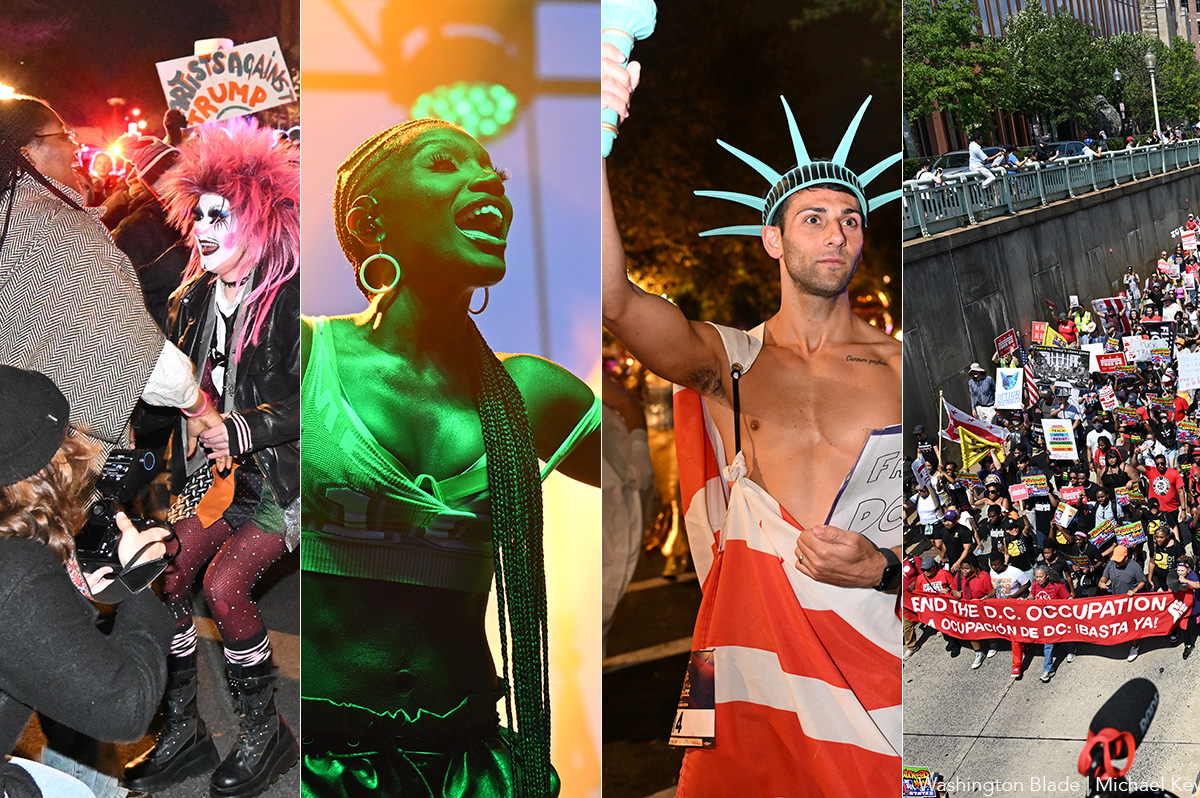
(Washington Blade photos by Michael Key)
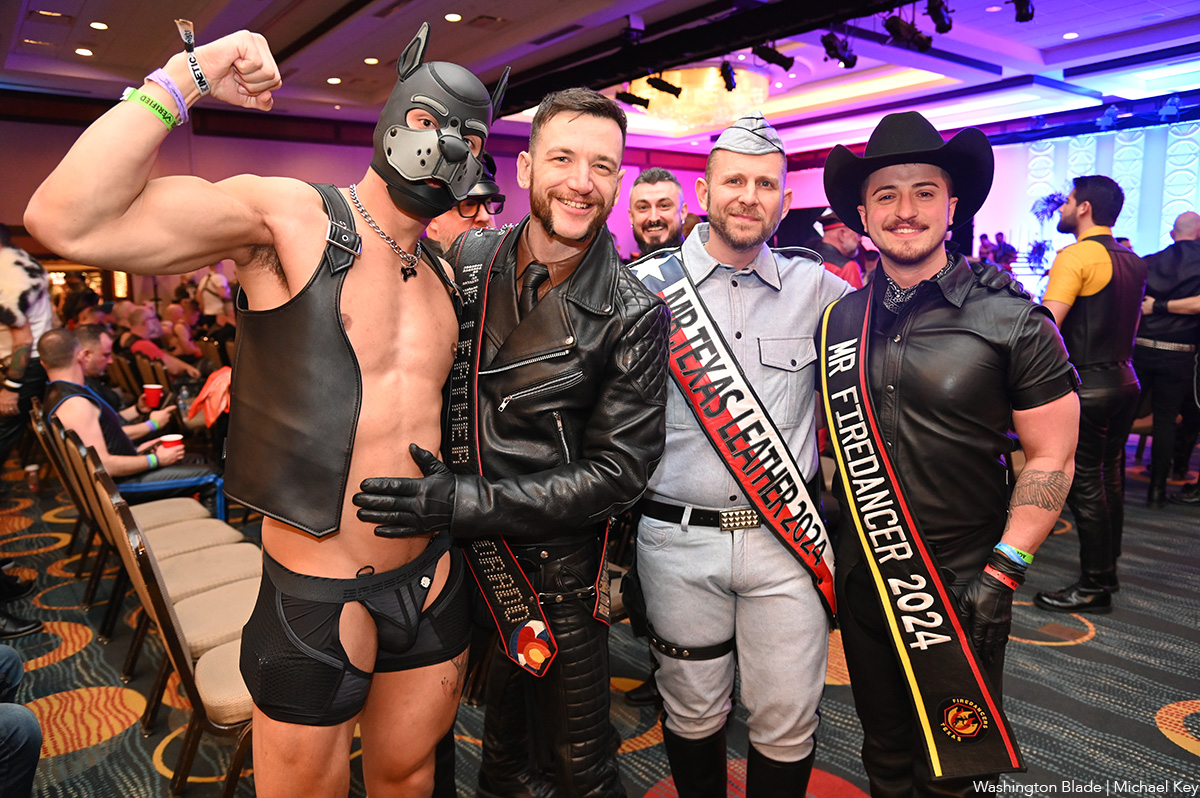
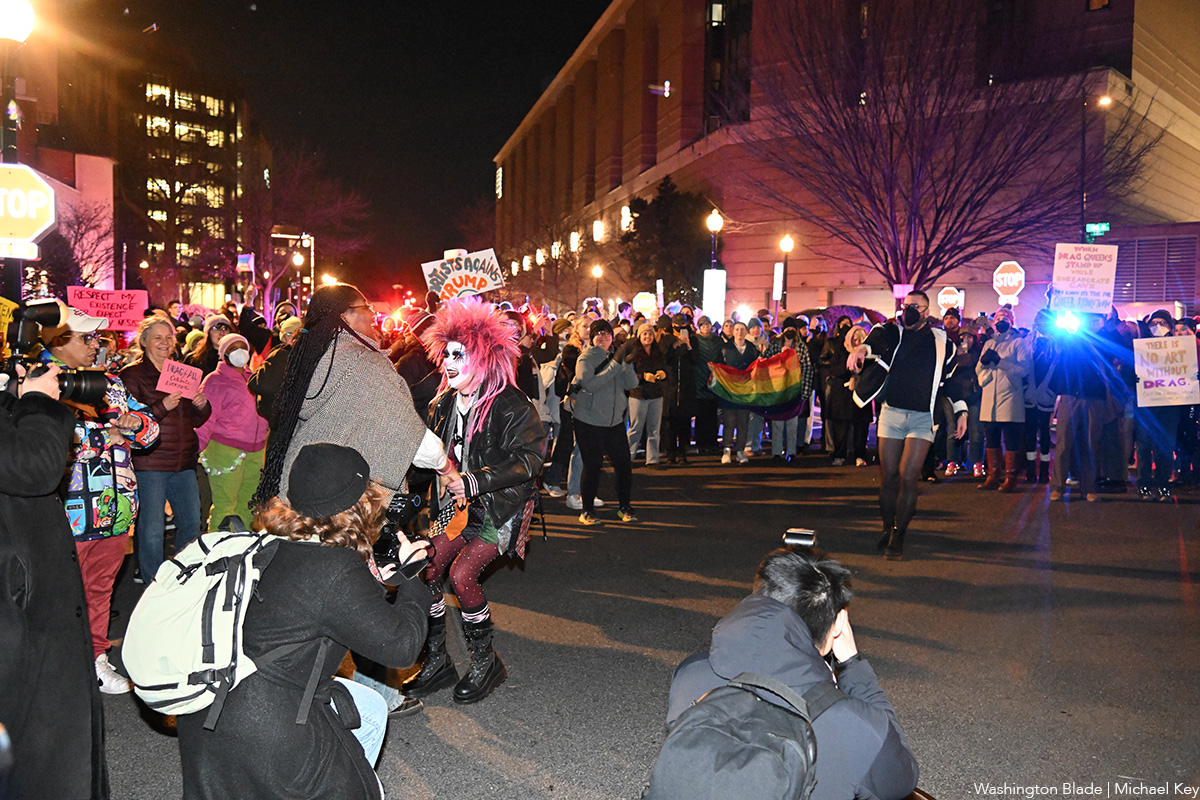
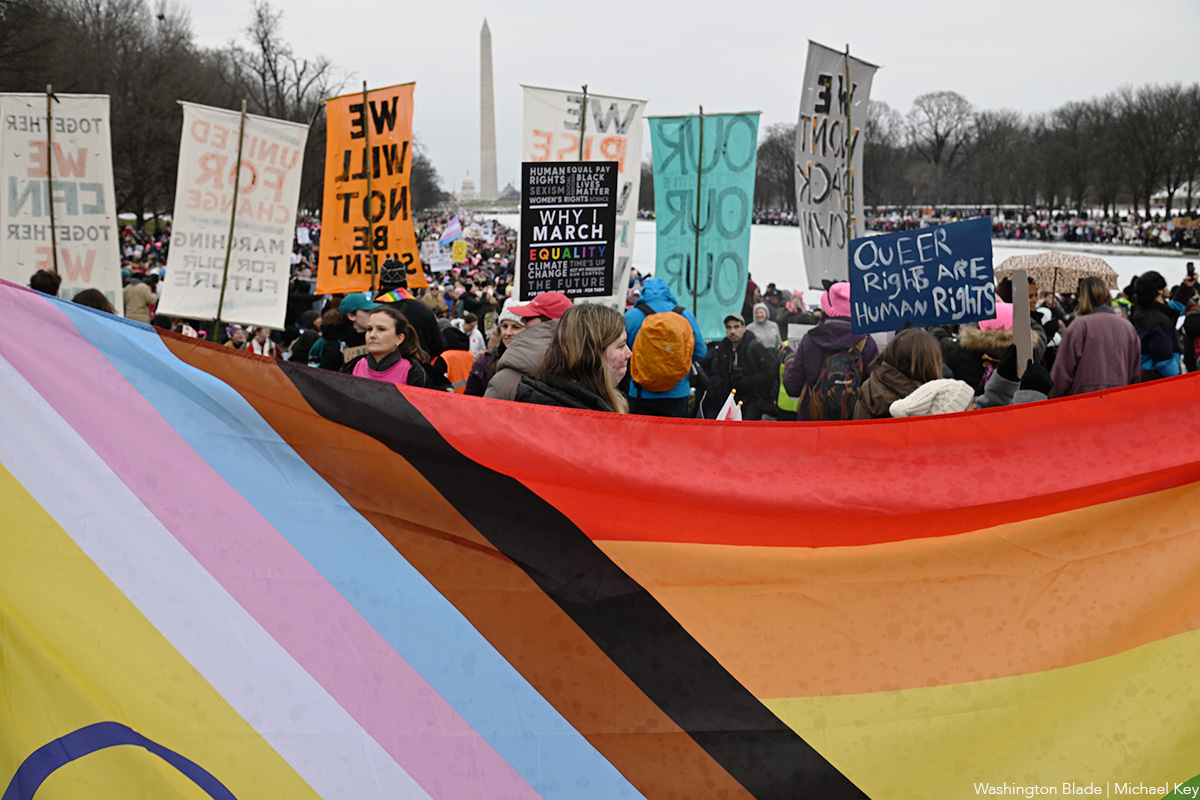
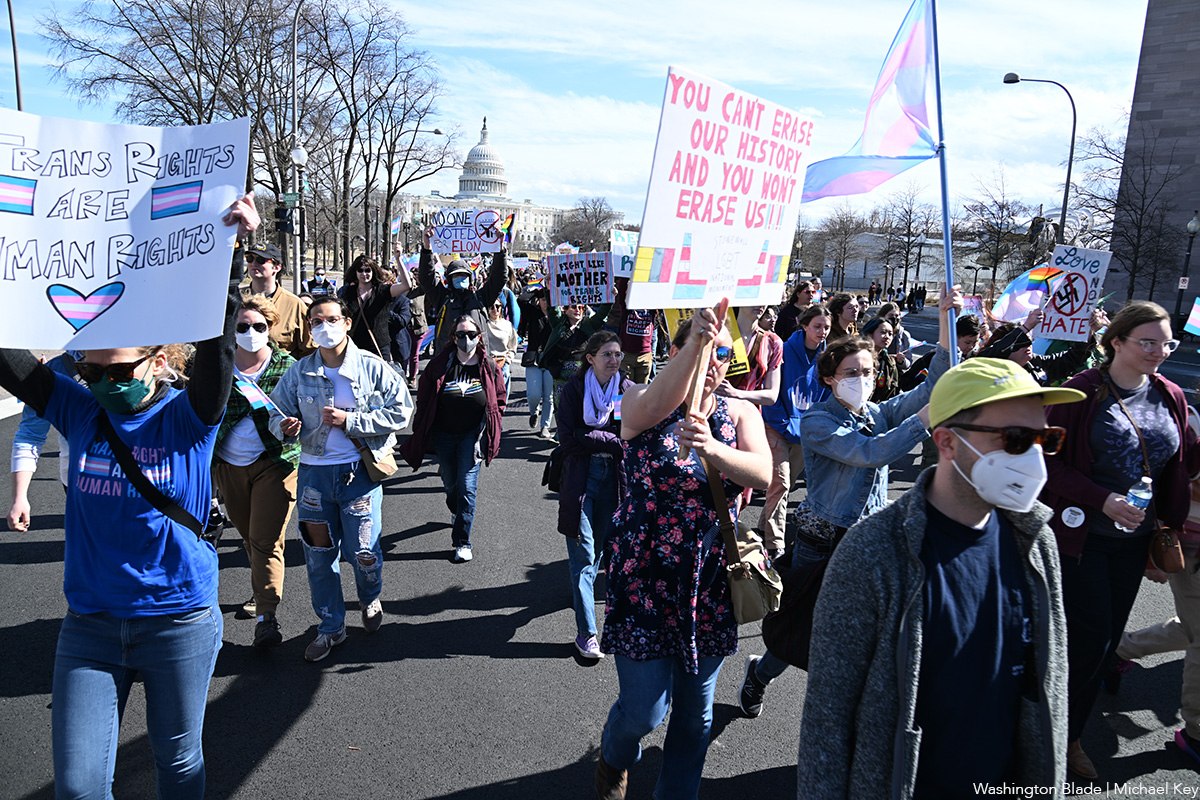
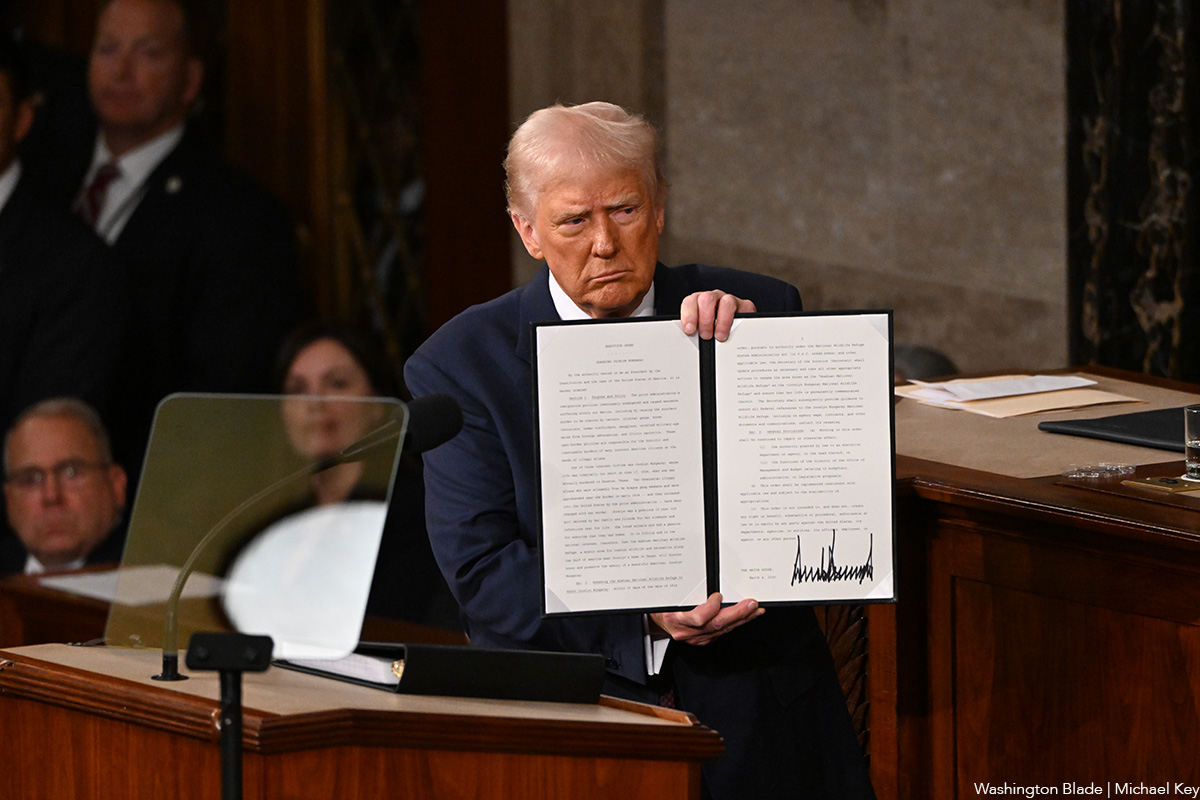
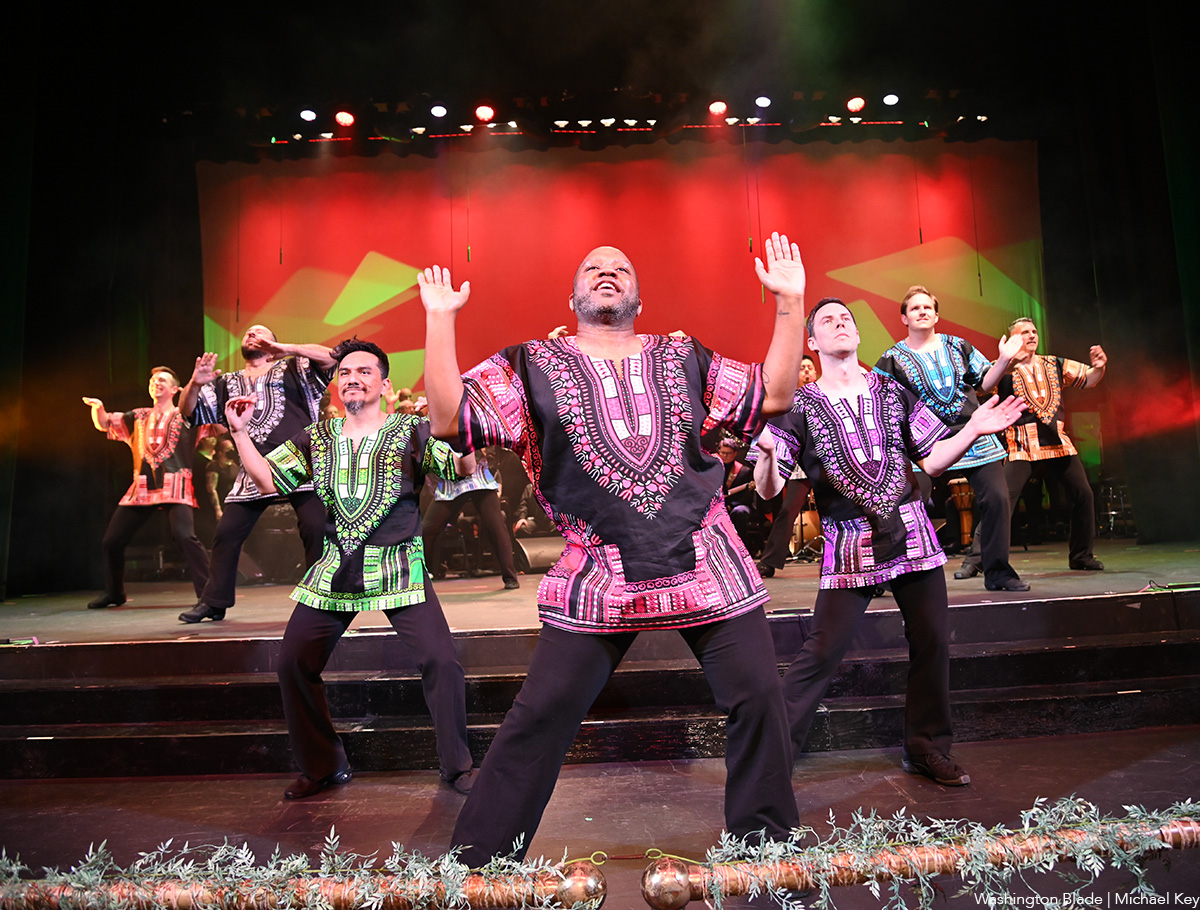
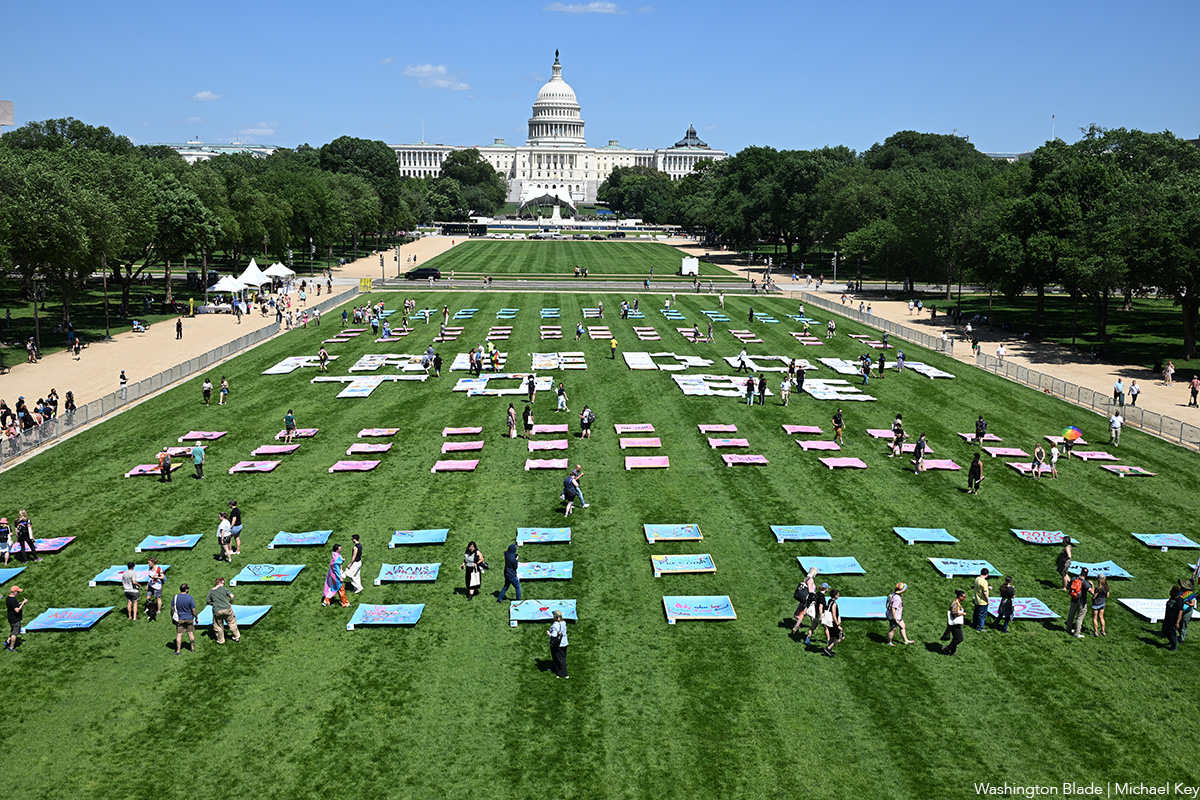
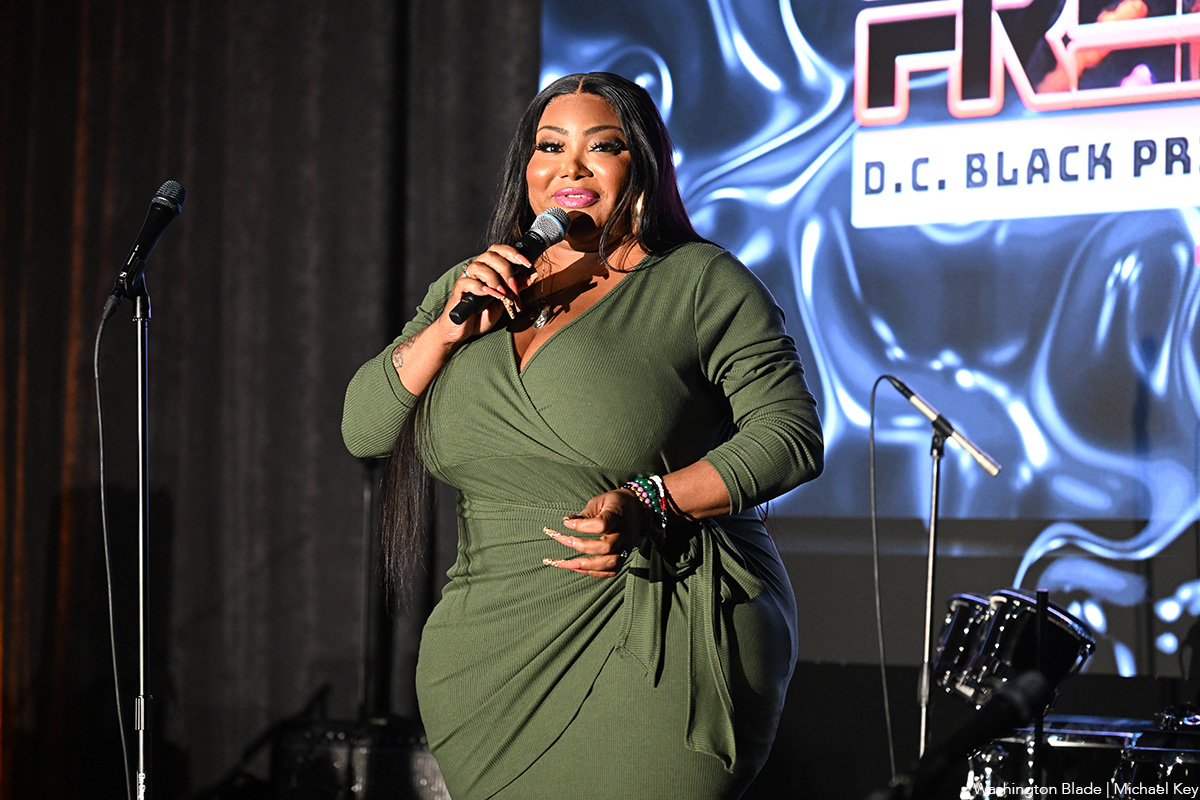
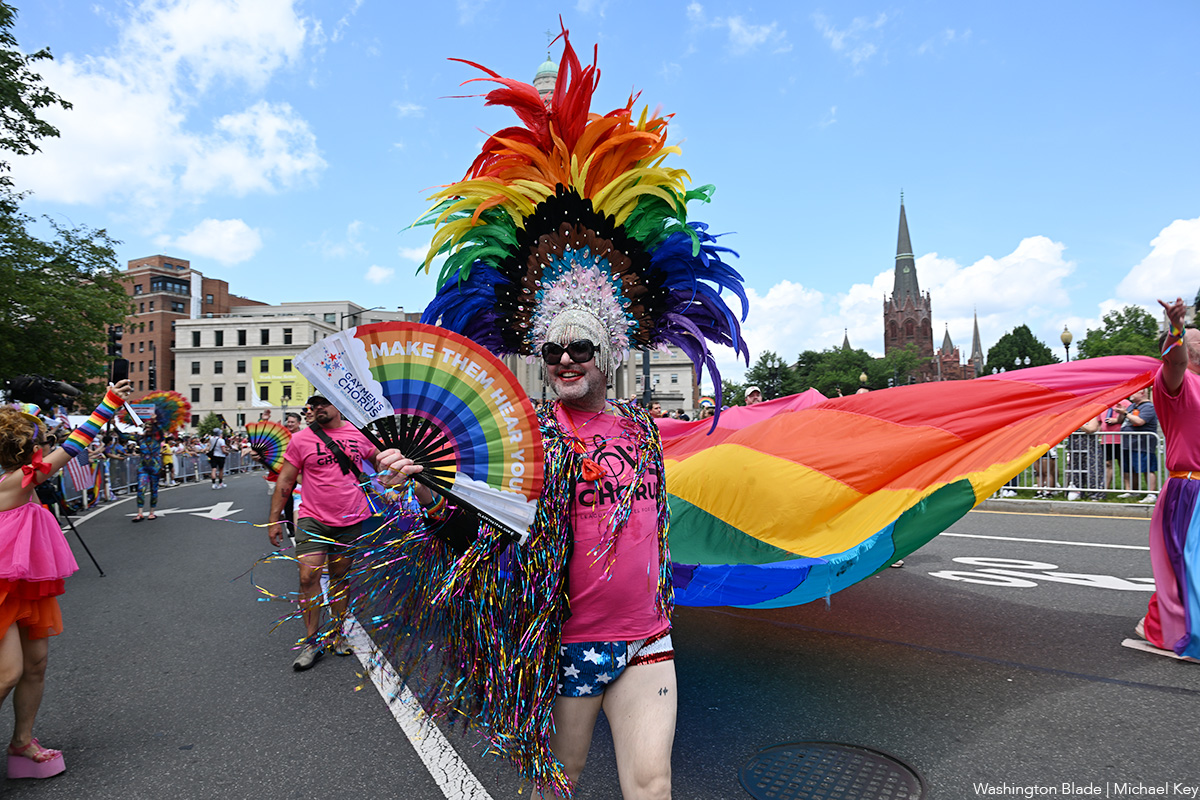
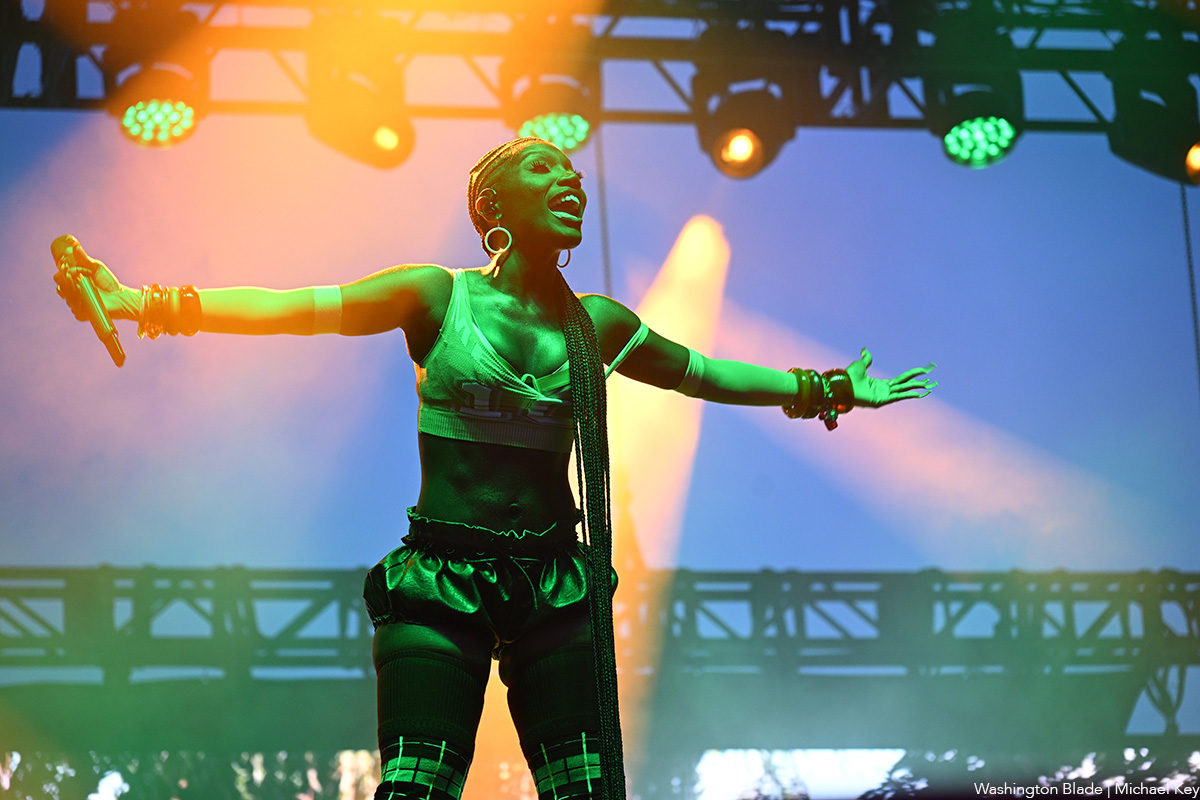
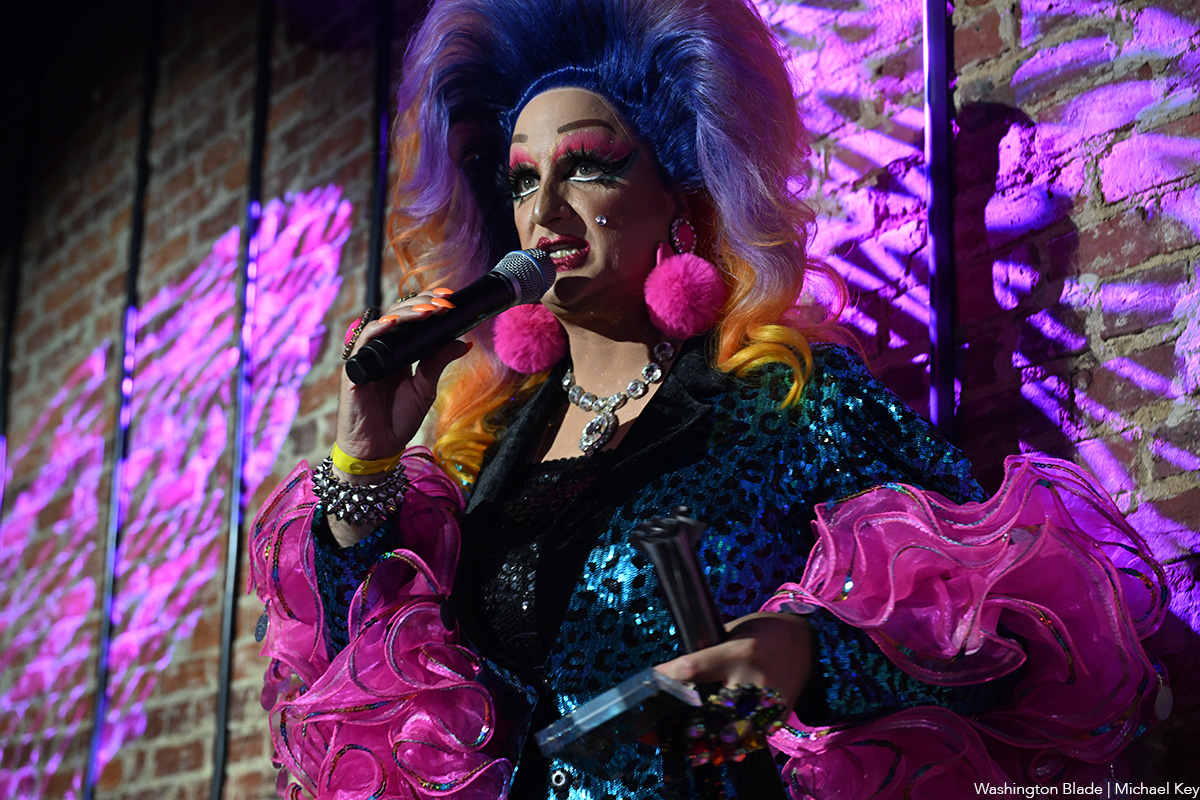
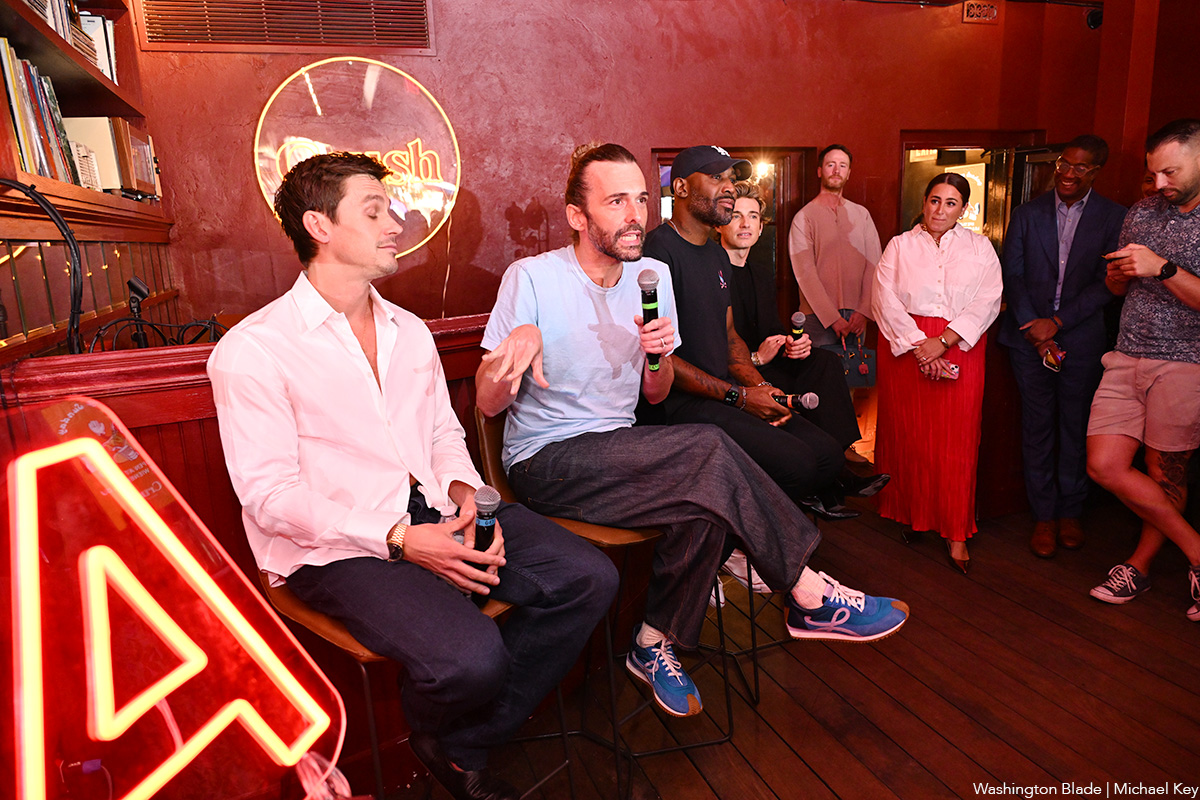

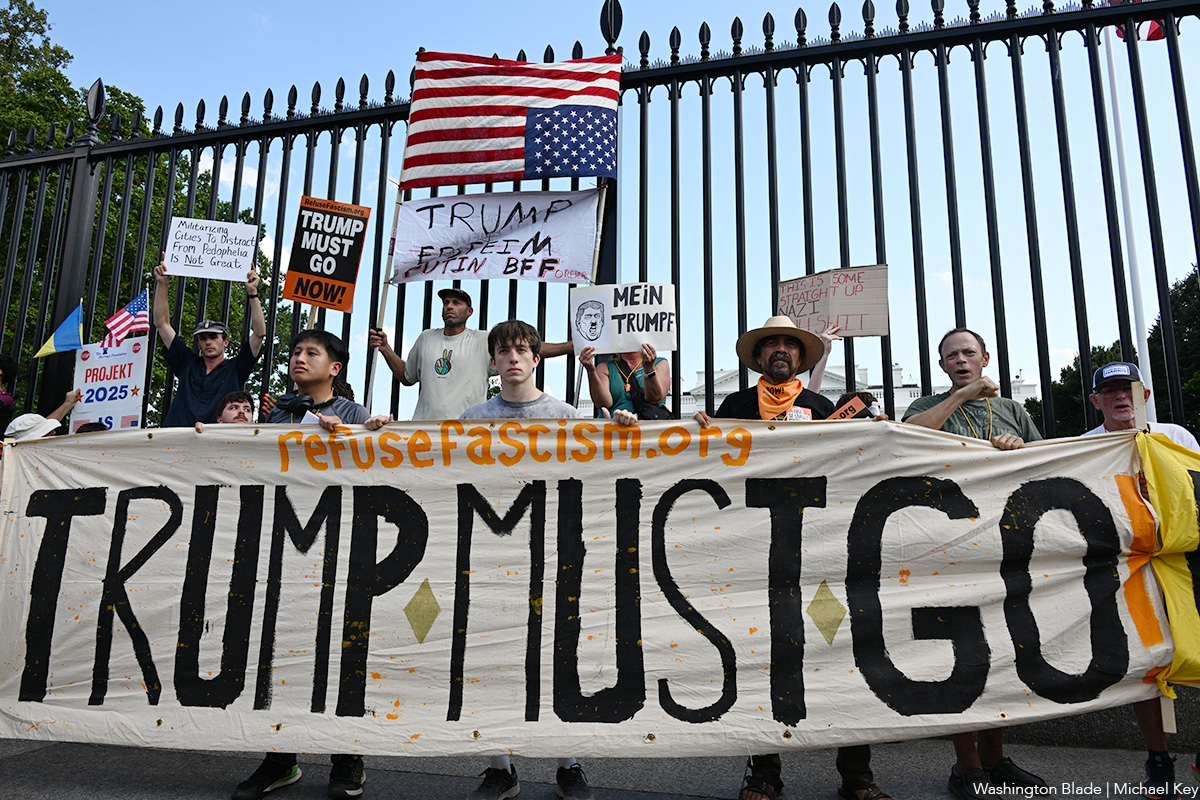
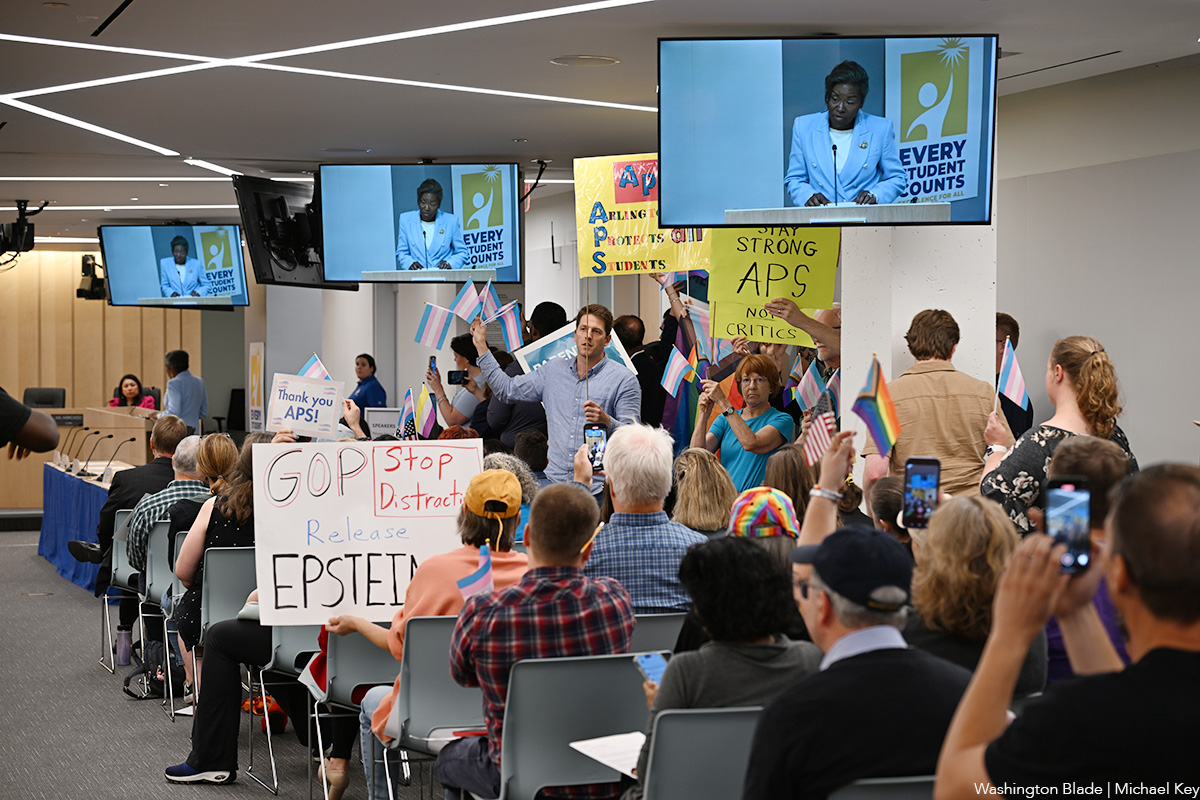
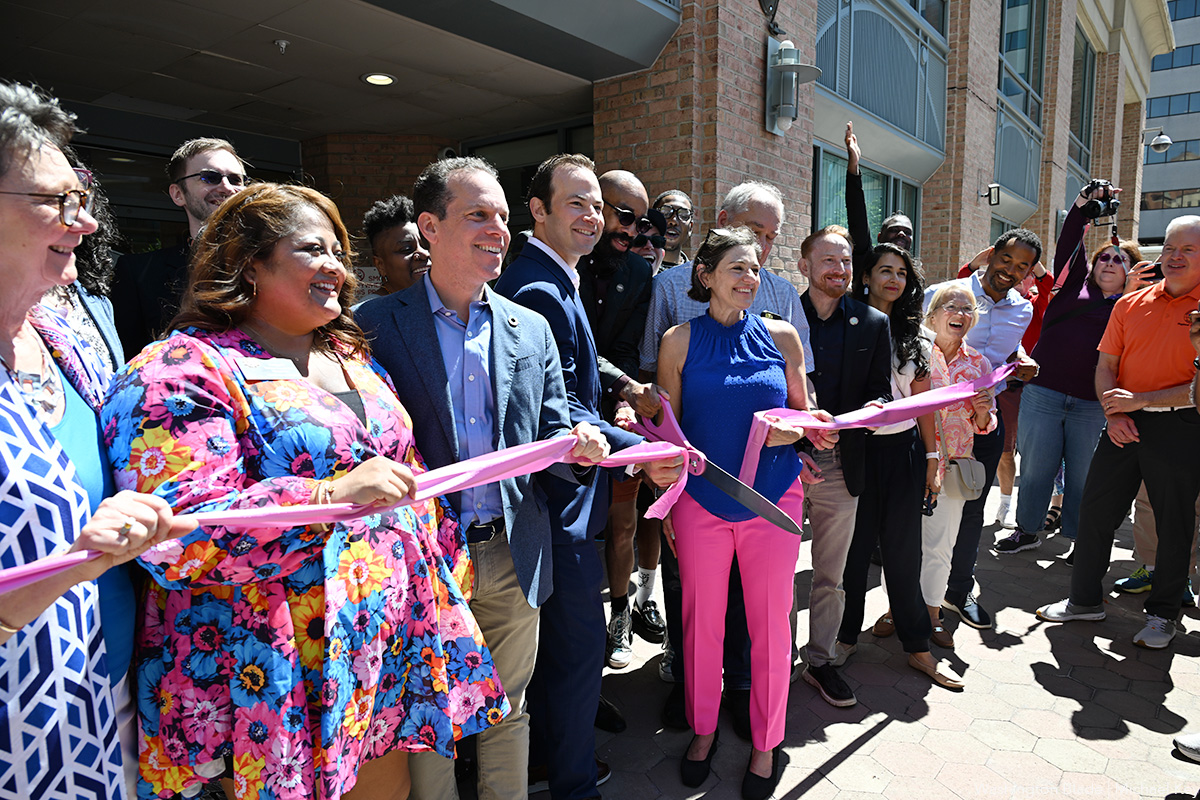

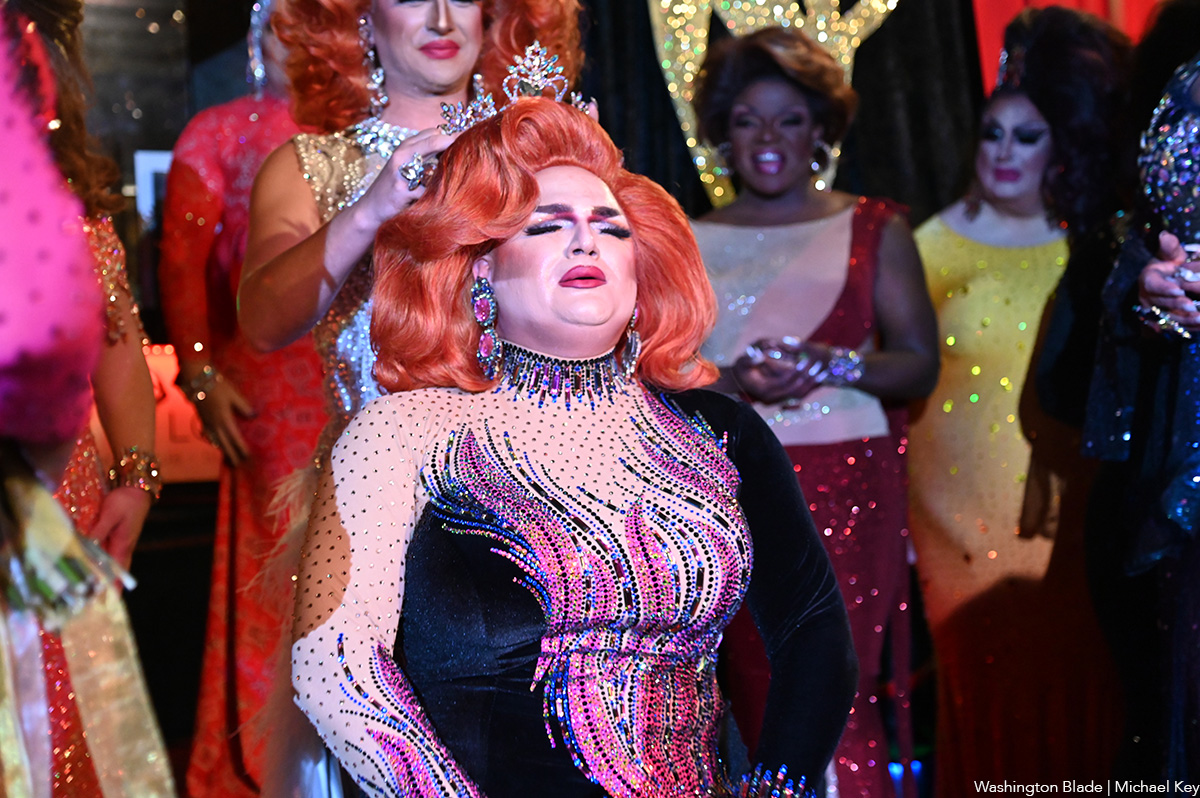

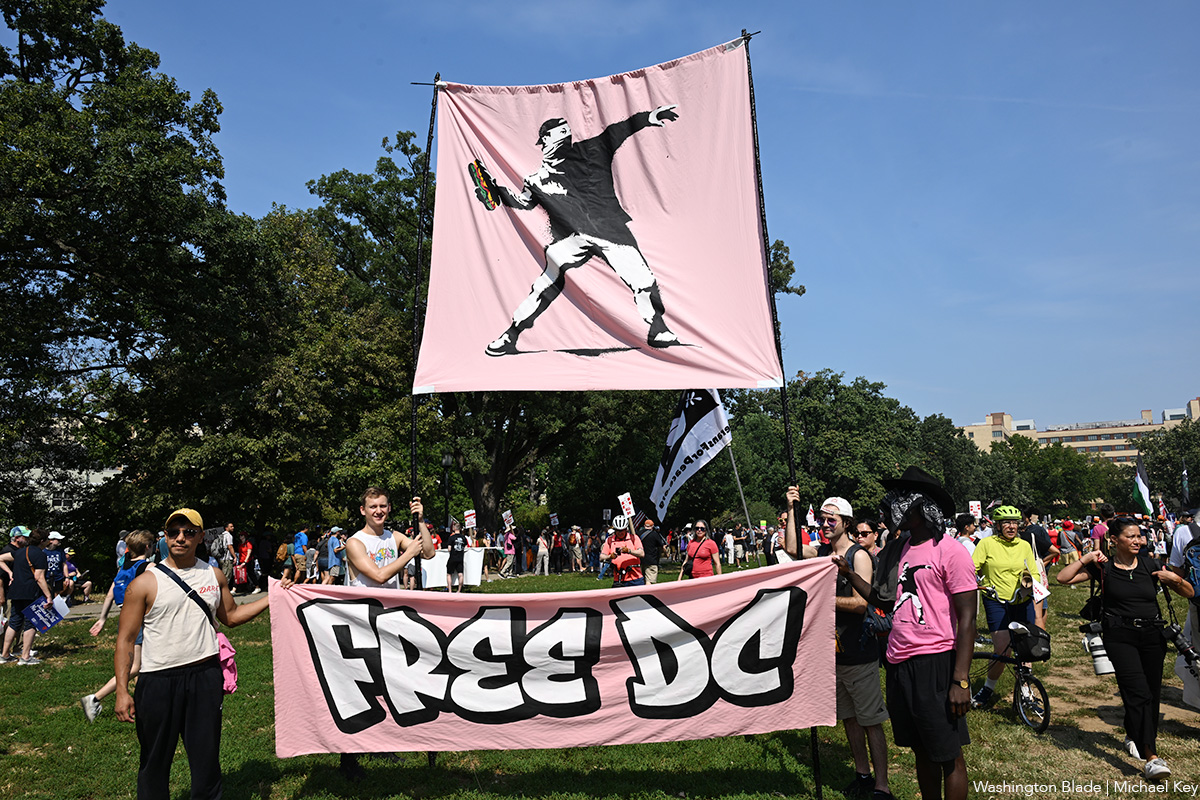
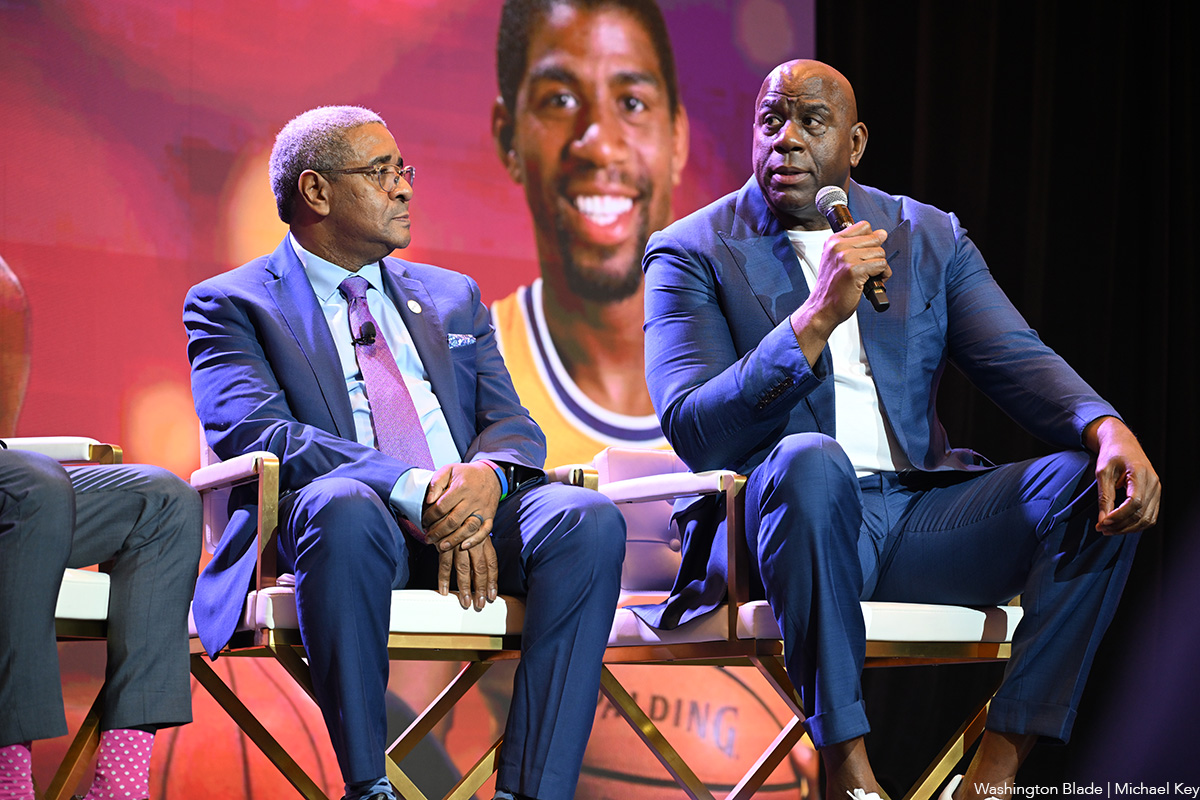

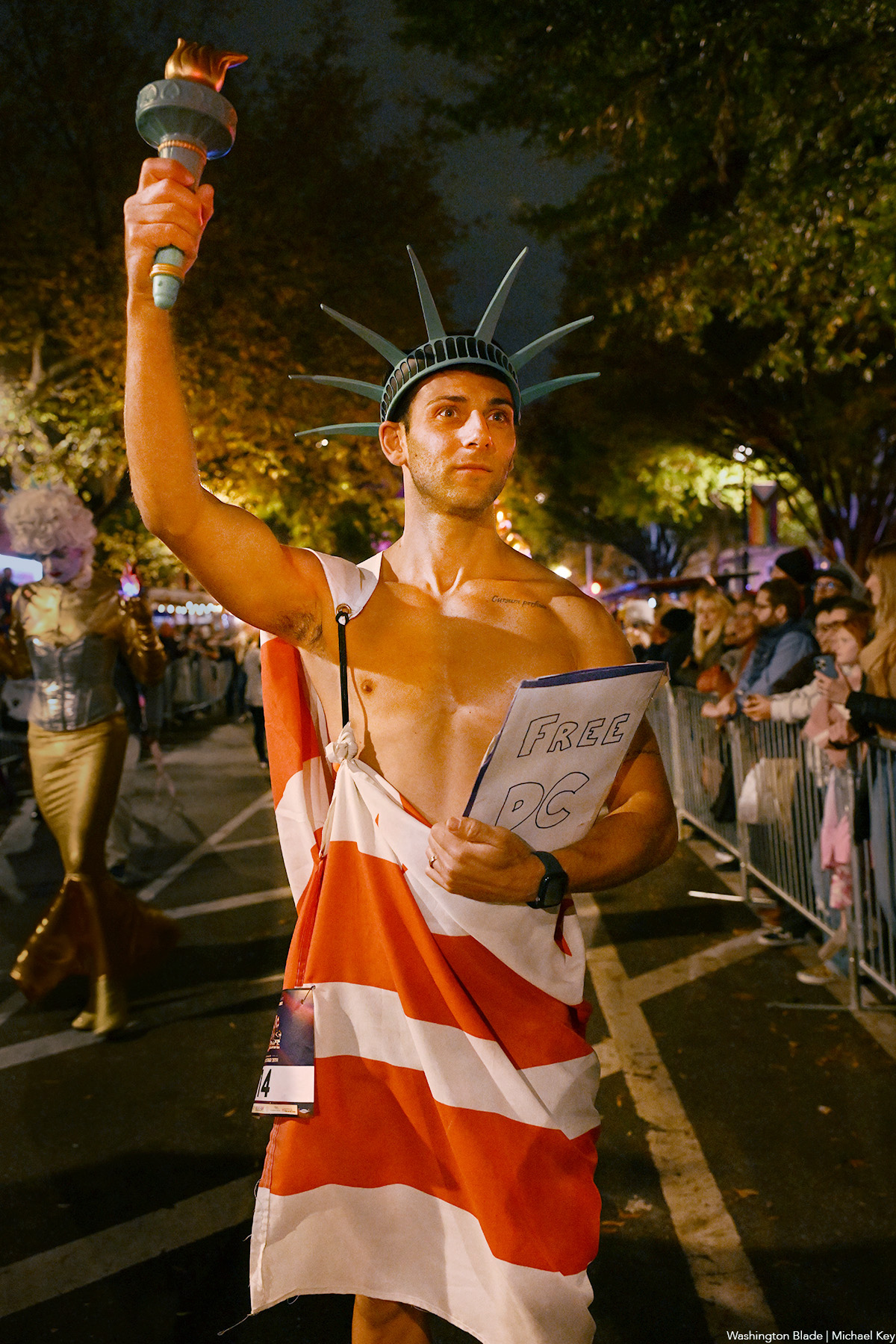
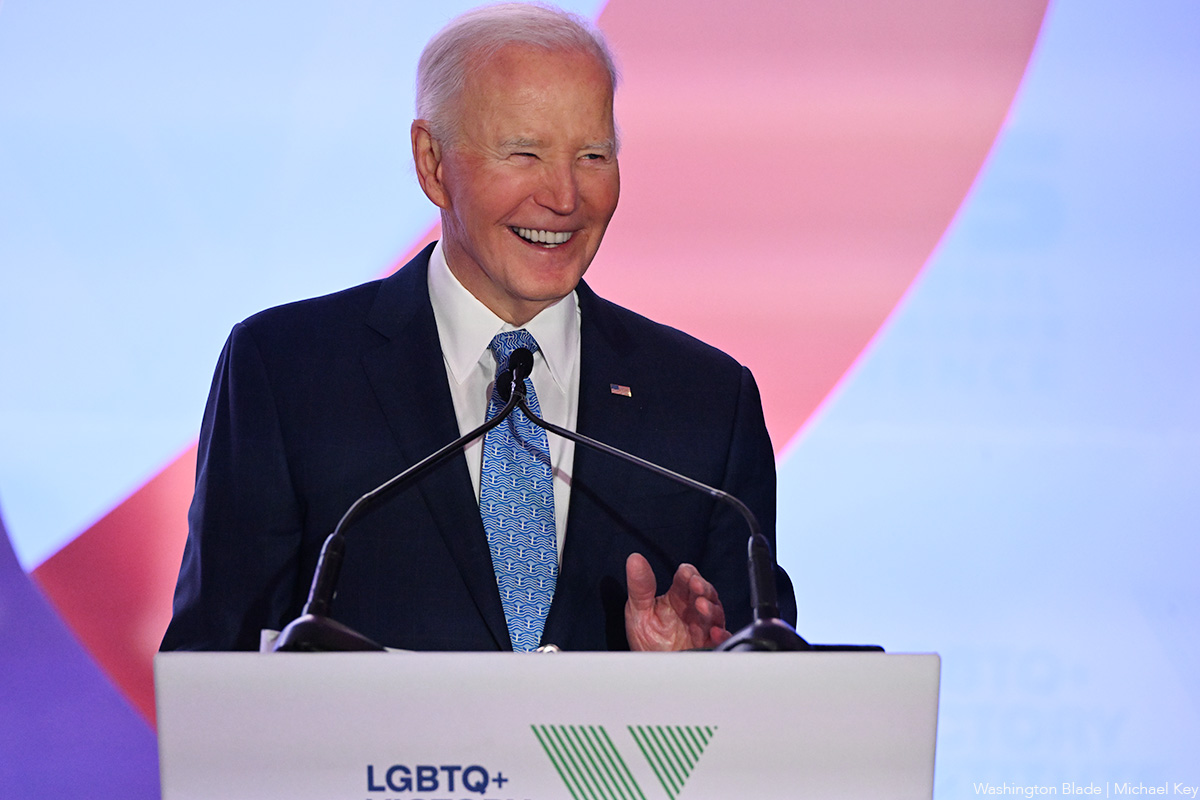
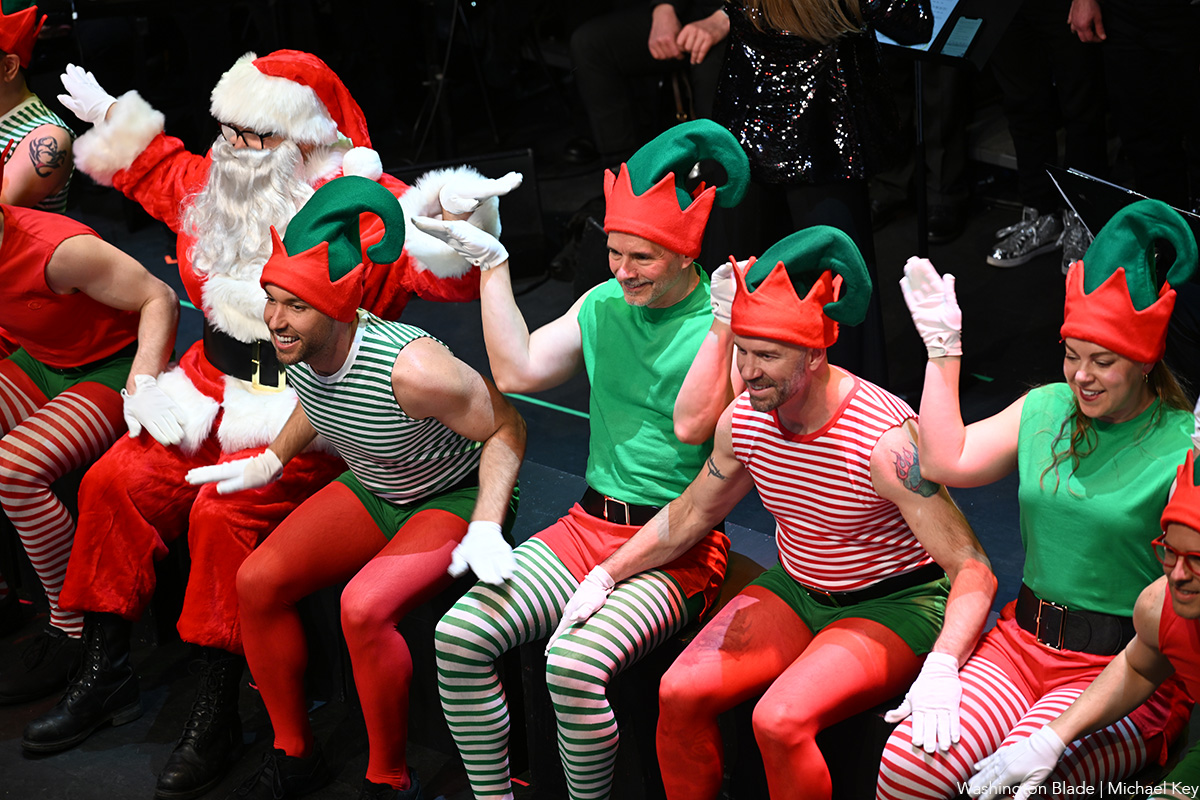

It’s been a year filled with drama and music, re-imaginings and new works. There was a lot on offer in 2025, and much to enjoy. Here are 10 now-closed productions that come to mind.
On Valentine’s Day at Folger Theatre on Capitol Hill, out actor Holly Twyford served as narrator for “The Love Birds” a Folger Consort work that melds medieval music with a world-premiere composition by acclaimed composer Juri Seo and readings from Geoffrey Chaucer’s “A Parlement of Foules”
Standing behind a podium, Twyford beautifully read Chaucer’s words (translated from Middle English and backed by projected slides in the original language), alternating with music played on old and new instruments.
While Mosaic Theater’s “A Case for the Existence of God,” closed in mid-December, it’s proving a production not soon forgotten. Precisely staged by Danilo Gambini, and impressively acted by Lee Orsorio and Jaysen Wright, the soul-searching two hander by out playwright Samuel D. Hunter, tells the story of two men who form an unlikely friendship based on single-fatherhood, a specific sadness, and hope.
The action unfolds in a small office in southern Idaho, where the pair discuss the perplexing terms of a mortgage loan while delving deep into their lives and backgrounds. Nothing is left off the table.
Shakespeare Theatre Company’s spring production of “Uncle Vanya” gave audiences something both fresh yet enduring. Staged by STC’s artistic director Simon Godwin, the production put an impeccably pleasing twist on Russian playwright Anton Chekhov’s classic. It ranks among the very best area productions of the year.
Featuring a topnotch cast led by Hugh Bonneville (TV’s “Downton Abbey”) in the title role, the play was set on an unfinished stage cluttered with costume racks and assorted props, all assembled by crew uniformed in black and actors in street clothes. Throughout the drama tinged with comedy, the actors continued to assist with ever increasingly period set changes accompanied by an underscore of melancholic cello strings. It was innovative and wonderful.
GALA Hispanic Theatre’s production of Manuel Puig’s “Kiss of the Spider Woman” was an intimate and affecting piece of theater. Staged by José Luis Arellano, it starred out actors Rodrigo Pedreira and Martín Ruiz as two very different men whose paths cross as convicts in an Argentine prison.
Arena Stage scored with a re-imagined and updated take on the widely liked musical “Damn Yankees.” Directed by Sergio Trujillo, the Broadway bound production has been “gently re-tooled for its first major revival in the 21st century,” moving the action from the struggling Washington Senators baseball team to the turn-of-the-century Yankees lineup. Ana Villafañe’s charmingly seductive Lola and a chorus of fit ball players made for a good time.
Also at Arena, out playwright Reggie D. White’s new work “Fremont Ave.” was very well received. A semi-autobiographical glimpse into home and the many definitions of that idea specifically relating to three generations of Black men, the work boasts a third act with a deeply queer storyline to boot.
Before his smash hit “Hamilton” transformed Broadway, Lin-Manuel Miranda wrote “In the Heights,” a seminal musical set against the vicissitudes of an upper Manhattan bodega. Infused with hip-hop, rap, and pop ballads, the romance/dramedy takes place over a lively few days in the vibrant, close-knit Latin neighborhood, Washington Heights.
Signature Theatre’s exciting take on “In the Heights” featured a talented cast including out actor Ángel Lozado as the bodega owner who figures prominently in the barrio and the action.
Studio Theatre’s recent production of lesbian playwright Paula Vogel’s newest work “The Mother Play,” a drama with humor, is about a well put together alcoholic mother and her two gay children living under difficult circumstances in the less glitzy parts of suburban Maryland. With nuanced performances and smart direction, the production was terrific.
Keegan Theatre surpassed expectations with its production of “Lizzie” a punk rock opera about Miss Borden, the fabled axe wielding title character. Performed by a super all-female cast, they belted a score that hits hard on subjects like money, queerness, and strained (to say the least) family relationships.
Round House Theatre impressed autumn audiences with “The Inheritance,” a two-part drama sensitively staged by out director Tom Story and acted by a mostly queer cast that included young actor Jordi Bertrán Ramírez in a breakout performance.
Penned by out playwright Matthew López, the epic work inspired by E.M. Forster’s novel “Howards End,” explores themes of love, legacy, and the AIDS crisis through the lives of three generations of gay men in New York City.
Prior to opening, Story commented that with the production’s predominately queer cast you get actors who “really understand the situation, the humor, and the struggle. It works well.” And he was right.

This past year, you’ve often had to make do.
Saving money here, resources there, being inventive and innovative. It’s a talent you’ve honed, but isn’t it time to have the best? Yep, so grab these Ten Best of 2025 books for your new year pleasures.
Nonfiction
Health care is on everyone’s mind now, and “A Living: Working-Class Americans Talk to Their Doctor” by Michael D. Stein, M.D. (Melville House, $26.99) lets you peek into health care from the point of view of a doctor who treats “front-line workers” and those who experience poverty and homelessness. It’s shocking, an eye-opening book, a skinny, quick-to-read one that needs to be read now.
If you’ve been doing eldercare or caring for any loved one, then “How to Lose Your Mother: A Daughter’s Memoir” by Molly Jong-Fast (Viking, $28) needs to be in your plans for the coming year. It’s a memoir, but also a biography of Jong-Fast’s mother, Erica Jong, and the story of love, illness, and living through the chaos of serious disease with humor and grace. You’ll like this book especially if you were a fan of the author’s late mother.
Another memoir you can’t miss this year is “Between the Devil and the Deep Blue Sea: A Veteran’s Memoir” by Khadijah Queen (Legacy Lit, $30.00). It’s the story of one woman’s determination to get out of poverty and get an education, and to keep her head above water while she goes below water by joining the U.S. Navy. This is a story that will keep you glued to your seat, all the way through.
Self-improvement is something you might think about tackling in the new year, and “Replaceable You: Adventures in Human Anatomy” by Mary Roach (W.W. Norton & Company, $28.99) is a lighthearted – yet real and informative – look at the things inside and outside your body that can be replaced or changed. New nose job? Transplant, new dental work? Learn how you can become the Bionic Person in real life, and laugh while you’re doing it.
The science lover inside you will want to read “The Grave Robber: The Biggest Stolen Artifacts Case in FBI History and the Bureau’s Quest to Set Things Right” by Tim Carpenter (Harper Horizon, $29.99). A history lover will also want it, as will anyone with a craving for true crime, memoir, FBI procedural books, and travel books. It’s the story of a man who spent his life stealing objects from graves around the world, and an FBI agent’s obsession with securing the objects and returning them. It’s a fascinating read, with just a little bit of gruesome thrown in for fun.
Fiction
Speaking of a little bit of scariness, “Don’t Forget Me, Little Bessie” by James Lee Burke (Atlantic Monthly Press, $28) is the story of a girl named Bessie and her involvement with a cloven-hooved being who dogs her all her life. Set in still-wild south Texas, it’s a little bit western, part paranormal, and completely full of enjoyment.
“Evensong” by Stewart O’Nan (Atlantic Monthly Press, $28) is a layered novel of women’s friendships as they age together and support one another. The characters are warm and funny, there are a few times when your heart will sit in your throat, and you won’t be sorry you read it. It’s just plain irresistible.
If you need a dark tale for what’s left of a dark winter season, then “One of Us” by Dan Chaon (Henry Holt, $28), it it. It’s the story of twins who become orphaned when their Mama dies, ending up with a man who owns a traveling freak show, and who promises to care for them. But they can’t ever forget that a nefarious con man is looking for them; those kids can talk to one another without saying a word, and he’s going to make lots of money off them. This is a sharp, clever novel that fans of the “circus” genre shouldn’t miss.
“When the Harvest Comes” by Denne Michele Norris (Random House, $28) is a wonderful romance, a boy-meets-boy with a little spice and a lot of strife. Davis loves Everett but as their wedding day draws near, doubts begin to creep in. There’s homophobia on both sides of their families, and no small amount of racism. Beware that there’s some light explicitness in this book, but if you love a good love story, you’ll love this.
Another layered tale you’ll enjoy is “The Elements” by John Boyne (Henry Holt, $29.99), a twisty bunch of short stories that connect in a series of arcs that begin on an island near Dublin. It’s about love, death, revenge, and horror, a little like The Twilight Zone, but without the paranormal. You won’t want to put down, so be warned.
If you need more ideas, head to your local library or bookstore and ask the staff there for their favorite reads of 2025. They’ll fill your book bag and your new year with goodness.
Season’s readings!
The Blade may receive commissions from qualifying purchases made via this post.

